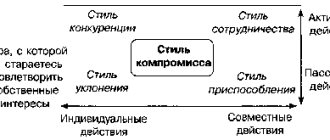Greetings, friends!
Every person knows and periodically uses the word “instinct”. For example, when explaining an unintentional action, we can say: “I did it instinctively.” However, many of us misunderstand what instinct is, with the result that the phrase often sounds like an inappropriate excuse. Today we will try to fill this gap and analyze in detail what instinct is. We will talk about the nature of this phenomenon, look at several examples and find out whether humans have instincts.
What is instinct?
Instinct is a pattern of behavior inherent at the genetic level, the purpose of which is to satisfy a specific need. Unlike a reflex, which is a single response to a specific stimulus, instinct implies a rather complex sequence of actions. All living beings have instincts aimed at solving such important problems as survival, food and procreation.
The term "instinct" comes from the modern Latin word instinctus, which has the same meaning. But the concept itself appeared earlier. Aristotle (4th century BC) suggested the existence of an “animal soul” that determines the behavior of animals. Later, the Athenian Stoic Chrysippus (3rd century BC) used the word ὁρμή (ormi) for this phenomenon, which became the equivalent of the word “instinct” in ancient Greek.
Instincts should not be confused with reflexes. The task of the reflex is to react in a timely manner to a specific stimulus. The task of instinct is to ensure that certain actions are carried out to ensure survival and procreation. Some instincts are common to all living organisms, while others are characteristic only of representatives of a certain species. The most complex instincts are observed in human behavior (the desire for power, recognition, social interaction, self-realization, self-development).
Many reputable psychologists denied the existence of instincts in human nature. Thus, Sigmund Freud believed that human romantic and sexual behavior is too complex to be explained by animal instincts (to explain this point of view, he developed the “Theory of Drives”). Abraham Maslow (the author of the hierarchical model of human needs) believed that people do not have instincts, since they, unlike animals, are able to restrain any impulses through willpower. According to Maslow, instincts in the human psyche are completely supplanted by thinking and replaced by emotions.
The biological meaning of instinct is to force an animal to perform a complex sequence of actions, some of which may be contrary to its current desires. Nevertheless, the animal carries out this “program,” thereby ensuring the survival of itself and its species. Instincts also manifest themselves in humans, but, unlike animals, he himself determines how he will act in order to realize the aspirations that arise in him.
In other words, a person cannot control the activation of instinct, but is able to control its manifestation.
Everything for life
that is, such actions that are innate and developed from generation to generation under the influence of external influences and are fixed through natural selection (successful, beneficial actions for the body are hereditarily fixed, but harmful ones are not repeated and are therefore lost). Instincts, as actions transmitted by inheritance, are based on unconditioned reflexes. Therefore, instincts change only slightly in the animal's personal experience. Since instincts have been developed over the course of many generations, they fully correspond to certain external conditions of life. When these conditions change, instinct still prompts the animal to act in the usual way, despite the fact that now these actions are clearly inappropriate. If you pierce a honeycomb, the bee will still carry honey in it. When one naturalist pulled a paralyzed cricket from a burrowing wasp's hole, the wasp still closed the hole's entrance, even though it could see that there was no one there. The auk bird moved aside the eggs on which it was sitting. Returning to the nest, she sat down in her previous, now empty, place, not paying attention to the eggs lying nearby. Beavers often build dams on bodies of water where the water level remains constant and, therefore, there is no need to build barriers for it. Instinctive behavior is the main form of mental activity in invertebrates, fish, birds, and also in other animals. Humans also have instincts. However, in humans these actions are usually subordinated to the intellect—the mind.
to next paragraph...
| When using site materials, a hyperlink to the resource www.biografia.ru is required |
Human instincts
Instincts in people are activated at an unconscious level and at this stage they act in the same way as in animals. We feel them as desires, emotions and needs, but we have the opportunity to independently choose how to implement them. At the same time, the implementation of an instinct usually brings a feeling of satisfaction, while the inability to realize it causes severe emotional discomfort. Therefore, the claim that a person can control his instincts is wrong. It’s just that, unlike animals, he has more freedom in choosing the way to realize these instincts.
In essence, our instincts are the evolutionary experience of our ancestors, accumulated and transmitted in genetic memory. Some behavior patterns turned out to be more successful and provided increased vitality to individual individuals, due to which they were fixed in genes. For example, the formation of monogamous couples and joint care of children are embedded in us at the genetic level, since hundreds of thousands of years ago such behavior helped our ancestors to survive and successfully raise viable offspring.
Are we more complex than spiders?
Primates and especially humans went even further in development and finally lost the remnants of instincts. Our behavior is very complex, but our mind is more flexible, so we do not need a clear program, and we can choose the easiest and most suitable solution from several solutions. Thanks should be given to the highly developed frontal lobe of the brain, where the centers for controlling behavior and acquiring skills are located. Thanks to it, we can satisfy our needs as the situation requires, and not follow straight lines laid by distant ancestors.
Opponents object: without instincts, all people would have died out long ago - take, for example, the ability of babies to cry loudly and for a long time or sneeze because of the fluff in the nose! However, this is just a reflex - a very simple (or slightly complicated) signal from the body to irritation. In general, the diagram looks like this: receptor - neurons - performer (for example, muscle). A receptor on the hand, or in the eye, or on the surface of the skin detects some kind of irritation, but we cannot do anything about it. But our sensitive neurons urgently transmit signals to the spinal cord, where simple but effective solutions are already “ripening”: jumping away from the flame or crying, washing a speck out of the eye.. Everything is simple and fast, the question is the answer. People have a lot of reflexes: some we are already born with (newborns have a lot of them, but as they grow older, many of them fade away), others we acquire in the process of learning and gaining experience.
So if you hear about someone’s unprecedentedly developed “self-preservation instinct,” know that, most likely, this person’s reflex arc simply works perfectly, and people do not have such an “instinct.”
More precisely, not a single animal in the world has it. “Instinct of self-preservation” is a collective image of many actions that representatives of fauna perform to survive. This includes the ability for long seasonal flights in birds, and the reflexive withdrawal of a hand from a hot object.
Examples of instincts
As a first example, consider the most obvious instinct - the instinct of self-preservation. It is characteristic of all types of living beings. Even the simplest animals strive to escape from predators and any other dangers. Quite often this instinct manifests itself in the form of unreasonable fears. So many people are afraid of heights, instinctively trying to grab something tightly (like our ancestors grabbed branches and vines). Others are afraid of water, so they experience discomfort even while on board a large ship. This is also a manifestation of the instinct of self-preservation.
The second example is the instinct of procreation. All animals also have it, but it manifests itself more diversely than the previous one. In some animals it is limited to sexual intercourse, after some time after which the female lays eggs and abandons the clutch (as in some turtles). Other animals form pairs and raise offspring together, but then separate and form new pairs the following season. Many animals are monogamous (some to a much greater extent than humans).
As a third example, consider maternal instinct. It can be considered an independent phenomenon or part of the reproductive instinct. It is usually activated after the first pregnancy and can manifest itself not only in caring for one’s own offspring, but also in the desire to protect the weak. Maternal instinct is characteristic of both humans and almost all animals. There are many known cases where in zoos females of one species raise orphaned cubs of other species.
VI. “Libertophilic type” (instinct of freedom)
Already in the cradle, a child of this type protests when he is swaddled. The tendency to protest against any restriction of his freedom grows with him.
People of this type are characterized by a desire for independence, denial of authority (parents, teachers), tolerance to pain, a tendency to leave their father's home early, a predisposition to risk, stubbornness, negativism, intolerance of routine, and bureaucracy. The credo of such people is: “Freedom above all.” And they are the guardians of everyone’s interests and freedom, individuality; they naturally limit the tendencies of individuals of the “dominant type.” They are the guardians of freedom, and with this, life.
The “libertophilic type” is characterized by:
- Tendency to protest, rebellion;
- Predisposition to change places (denial of everyday life);
- The desire for independence;
- Tendency to reformism, revolutionary changes;
- Intolerance to any form of restrictions, to censorship, to the suppression of the “I”.
Classification of instincts
Human instincts are aimed at realizing the basic needs inherent to our species. The most important are 7 instincts:
- Self-preservation. This is a basic instinct that appears in all animals immediately after birth. The child cries so that he will not be left without attention. Growing up, he learns to distinguish dangers and avoid them. At the same time, he acts in accordance with his life experience, but the desire to avoid danger is instinctive.
- Continuation of the family. This instinct is just as important as the previous one, since its task is to ensure the preservation of the population. The reproductive behavior of animals of different species is very different, but in all cases it is due precisely to the instinct of procreation.
- Curiosity. Surely you have noticed that curiosity is characteristic of many animals. This is how the research instinct manifests itself. Dogs, cats, birds and even fish study with interest everything new and incomprehensible. This allows them to understand in advance which objects pose a danger and which may be useful.
- Dominance. The instinct of dominance exists in many animals, but in humans it is especially pronounced. Even if a person does not strive for power, he still wants to have influence on others, to be a “gray eminence.”
- The desire for freedom. This instinct manifests itself even in an infant who resists when they try to swaddle him. Growing up, the child violates the prohibitions of his parents. Even if the violation itself does not bring him anything, he rejoices in the fact that he satisfies his instinct for freedom.
- Adaptation. Any animal and person undergoes gradual adaptation to the environment and living conditions. The ability to adapt is also inherent in our nature on an instinctive level.
- Social communication. The communicative instinct makes us strive to communicate with other people, do business together and help each other.
How do birds find their way south?
Speaking of birds. Twice a year, migratory birds accomplish something truly grandiose, if not impossible, and it is not only about overcoming vast distances, but also about choosing the direction of migration. They use many sources of information: the position of the sun and stars, some landmarks, and the planet’s magnetic field.
It seems that this is true instinct: having never been to a wintering place, the bird feels the need to fly exactly there. But in fact, young individuals do not immediately understand where they need to go, and only over time they comprehend the all-wise science of navigation. However, how this happens still remains a mystery. In some species, youngsters simply follow their flock, studying the route, while in others, apparently, the ability to choose the right direction is genetic (if you cross birds with different types of migration, the offspring may get lost).
So instinct is instinct, but it still needs to be learned. But the need to migrate clearly manifests itself instinctively: when the length of daylight changes, physiological changes are triggered in the birds’ bodies, which prompt them to prepare for migration, and then to fly.
Differences between instincts and reflexes
To better understand what instinct is, it is important to correctly understand how it differs from a reflex. The fundamental difference is that a reflex is a reaction of the nervous system that occurs immediately in response to a certain stimulus. Some reflexes can be restrained by willpower, but most of them are not under the control of our mind and will. There are two types of reflexes:
- Unconditioned reflexes. They are also called “congenital” or “specific”. They are embedded in genes and are characteristic of all individuals of one biological species. They manifest themselves regardless of life experience.
- Conditioned reflexes. They are also called “worked out”. They are formed during life to ensure a quick response to positive and negative environmental factors. If a conditioned reflex loses its relevance, it weakens and may disappear completely.
Despite significant differences, unconditioned and conditioned reflexes have a common nature and approximately the same trigger mechanism. The nerve impulse received from the receptor passes along the reflex arc and excites the systems (muscles or glands) that provide a response. All reflexes occur automatically and without awareness, and their cause is always some kind of irritant.
Unlike reflexes, instinct is a complex pattern of behavior that is not limited to the activation of a specific muscle or the secretion of a gland. Instinct can be compared to a trigger mechanism, the activation of which launches a complex program of actions. In this case, the program can be very conditional. Instinct arises as a strong need that requires satisfaction. And how exactly to satisfy it depends on the animal or person.
III. "Altruistic type"
People of this type are characterized by kindness, empathy, caring for loved ones, especially the elderly, and are able to give the last to others, even what they themselves need. They are convinced that it cannot be good for everyone if only one person is bad, and their credo is “Kindness will save the world, kindness is above all.” And they are evolutionary guardians of kindness, peace, guardians of life.
The “altruistic type” is characterized by leading qualities:
- Kindness;
- Empathy, understanding of people;
- Unselfishness in relationships with people;
- Caring for the weak and sick;
- Peacefulness.
Have human instincts disappeared?
As noted above, many famous authors believed that man does not have instincts, since they were supplanted by reason. However, from the point of view of modern psychology, such a statement is erroneous. A person really controls his own behavior and when making decisions he is guided not by instincts, but by common sense. But this does not negate the fact that many of our desires, goals and aspirations are dictated precisely by instincts. Our difference from animals lies only in the fact that we ourselves choose how to satisfy our own needs and desires.
We fully have the instinct of self-preservation. In critical situations, it often takes precedence over reason, as a result of which a person begins to panic and behave irrationally. But the older and more experienced we become, the easier it is to cope with panic in critical situations. Another example is mating behavior, which in people is highly “regulated” by culture. Each of us from a young age understands that there are some rules that determine what a romantic relationship should be like and on what date you can kiss. However, the very desire to enter into such relationships is dictated by nothing more than the instinct of procreation.
Thus, no matter how intelligent human activity is, it is still motivated by the most ordinary instincts. It’s just that instincts no longer directly control our behavior, like in animals. But the activation of instinct gives us a strong (sometimes irresistible) desire to perform some action. And how we carry them out depends on ourselves, our education and upbringing, moral and moral principles. All people have instincts and persist throughout life, but we restrain them, since their uncontrolled manifestation causes condemnation in modern society.
IV. "Research type"
From early childhood, people of this type are characterized by curiosity, a desire to get to the essence of everything, and a tendency to creativity. At the beginning, these people are interested in everything, but then they become more and more captivated by one passion. Travelers, inventors, scientists are people of this type. Their credo is “Creativity and progress are above all.” The evolutionary feasibility of this type is obvious.
The “research type” is characterized by:
- A penchant for research;
- Tendency to search for new things, innovation in science, art, etc.;
- The ability to leave a settled place and established business without hesitation when new, risky, but interesting activities and tasks appear;
- Striving for creativity;
- Selflessness in realizing creative aspirations.
Structural analysis of instinctive action
1. Appetence is the tense state of an animal caused by current needs. Instinctive action will not begin if there is no appetite.
2. Signals that serve as a trigger stimulus. The trigger stimulus is called an evocator. Evocators can be different (closing the light for the baby bird before feeding). The evocator orients the animal by giving it information that the situation is appropriate for this behavior.
3. Execution, which are operations that complete an action by achieving a result.
Instinctive behavior is characteristic of all organisms with a psyche, including humans. Instinctive behavior of a person is transformed by culture, which is introduced by upbringing, as a result of which the elements of instinctive actions acquire specific human forms, from which the essence of instinctive behavior does not change.
Instincts that have complex structures (the nest-building instinct) are realized provided that the components included in their structure were formed in the individual’s experience.










